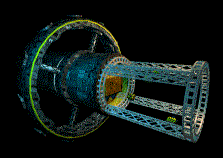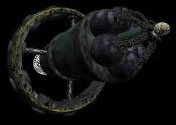OPNET Resource Vehicle Data
Fangtech / Bakuhatsu Outpost Orbital Station

Description
The Outpost was designed around its central hangar. Located at the center of the station and surrounded by the skeleton-like framework of the docking gantry, this hangar is kept in zero gravity to accommodate the easy transportation of cargo from ships to the station. Behind the hangar is the extensive storage space, and an area that varies in functionality. (Typical layouts are labs or factories, depending on the specifications of the buyer.) Nestled in the core of this is the Bakuhatsu B-95 hyper fusion power core. This ancient reactor is bulky, but very powerful and reliable. Two smaller backup reactors are located fore and aft of the primary. The original design team deemd that because this station was designed for deep space, solar panels would not be included. Their efficiency would be minimal, and their cost too great.
Anyone who works in space for extended periods of time risks atrophy of their muscles and damage to their bones and heart. On more expensive stations, LAO and other unpleasant effects are held off by grav-crystal lattices, but these are expensive and require constant maintenance. Instead, the Outpost has a half kilometer-wide ring that spins to produce one-half gravity. This ring contains most of the crew cabins and living spaces.

History
In 2110, Australian marine systems corporation Fangtech and Nihonjin space systems manufacturer Bakuhatsu began a joint project for the development of a cheap but reliable space habitat. This design would be cheap enough to produce in large quantities, while being sturdy and reliable enough to keep maintenance costs low. The goal was an ideal station for smaller mining or research companies. The result was the Outpost-class space station.
The Outpost has been a very successful product for Fangtech & Bakuhatsu. In the first year of sales, six were ordered by Ares Inc. to be converted into belt mining platforms. Since then, eight more have been ordered from smaller companies to serve the same function. At the time of this article's publication, there are three dozen Outpost stations littered throughout the solar system, as well as five that were transported to colony worlds by the Upeo Wa Macho prior to 2114 (only one of which was still inhabited upon recontact). Small time entrepreneurs have set some up as deep space trading towns or supply depots. Others exist as small research or manufacturing stations.
Certain Outpost stations serve interesting functions and have received their fair share of media attention. Outpost 29 was purchased by the Seventh Legion and put into orbit between Earth and Mars. Nicknamed "the Firehouse," it acts as a base of operations for space patrol and rescue units. Although aged, Outpost 29 continues to spin and serve its function well.
Statistics
VT:
Space StationTech: Hard
Crew: Only six are needed
Cabins: Room for 72. This is split into 12 dorms, each with 6 bunks and living facilities.
Cargo: 1,150,000 cumets (not including crew life support and provisions)
Ship Complement: Docking tower big enough for even the largest freighters. Internal space for approximately 400 tons of smaller spacecraft.
Mass: 210,000
Cost: 10
Armor: 6 [10]
Weapons: Widely variable. The following is a typical configuration-
(2) Turretted Heavy Lasers (Acc +3, Dam 8d10[5]L)
(1) Missile Bay with 20 Smart Missiles (Acc +3, Dam 8d10[15]L)
Other:
Optional 1,150,000 cumets of laboratory, manufacturing, or storage space